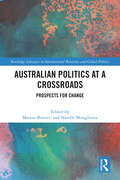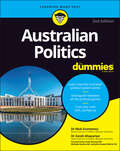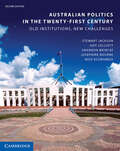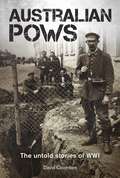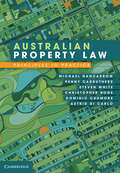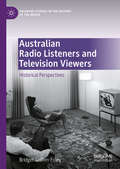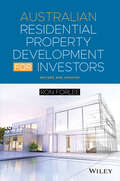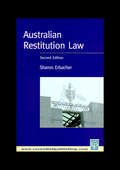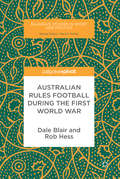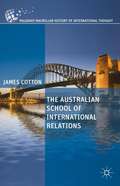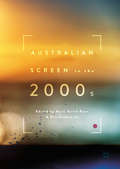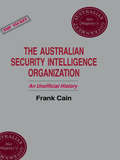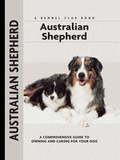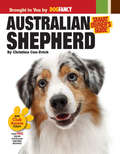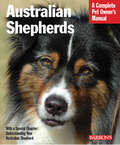- Table View
- List View
Australian Politics at a Crossroads: Prospects for Change (ISSN)
by Matteo Bonotti Narelle MiragliottaAs the 21st century proceeds apace, Australia faces new and old challenges, both domestically and internationally. These include managing complex governance issues, preventing democratic fracture, balancing an ever- shifting geopolitical strategic order, addressing the recognition and identity demands of marginalised groups, and responding to crises and urgent policy challenges, such as climate change.Bonotti, Miragliotta, and the other contributors to this volume analyse and evaluate the challenges which confront Australia by locating them in their national and comparative context. The various contributions reveal that while these challenges are neither novel nor unique to Australia, the way in which they manifest and Australia’s responses to them are shaped by the country’s distinctive history, culture, geography, location, and size.The chapters offer a cutting- edge analysis of these pressing challenges faced by Australia and offer reflections on how to address them. The book is a valuable resource for scholars and students of Australian politics, and of comparative politics in a global perspective.
Australian Politics For Dummies (For Dummies Ser.)
by Nick Economou Zareh GhazarianCreated especially for the Australian customer! Understand the Australian political system and make your vote count Get to grips with the good, the bad and the ugly of Australian politics! Whether you're a seasoned political punter or a voting novice, this is your essential guide to understanding politics in Australia. Master the ins and outs of elections, parties and policies, and learn to discuss the big issues in no time. You have to vote — now learn whyand how. Decipher political terminology — clear explanations of the houses of parliament, voting systems and more Learn how Australia's political system evolved — how Westminster and Washington were combined to produce 'Washminster' Appreciate parliamentary roles — what the Whips do and just what the Usher of the Black Rod is Find out who holds the purse strings — how federal and state governments work out who pays for what Understand how political parties work — the differences between Labor and Liberal, and what coalition politics is Discover what's meant by the balance of power — how minor parties and independents contribute to politics Determine how your vote is counted — the difference between preferential voting and proportional representation Work out the media's role — how the media reports, interprets and sways political outcomes Open the book and find: Key points about past and current political hot topics Explanations of the Australian Constitution, including the crisis of 1975 Plans of the houses of parliament so you know who sits where Analysis of how the major Australian political parties came about A concise description of the electoral pendulum Graphic descriptions of the different ballot papers A comprehensive glossary of political terms and jargon Learn to: Identify what makes the Australianpolitical system tick Distinguish between the differentpolitical parties Understand the influence of the media in Australian politics Cast your vote with confidence
Australian Politics For Dummies
by Nick Economou Zareh GhazarianUnderstand Aussie politics and make your vote count! Australian Politics For Dummies gives you a helping hand as you get to grips with the good, the bad and the ugly of Australian politics. Seasoned political punters and voting novices alike will find fascinating facts and top thrills in in this essential guide. Master the ins and outs of elections, parties and policies. In no time, you'll be discussing and debating the biggest issues with ease. Down under, we all have to vote. It's one of the many beautiful things about this land of ours, and this book will help you learn why (and how) to cast that ballot. This updated edition gives you everything you need to cast your vote with confidence. You'll identify what makes the Australian political system tick, distinguish between the different political parties and understand the influence of the media in Australian politics. Decipher political terminology, make sense of the houses of parliament and understand why we have minor parties Learn how Australia's political system evolved and grasp today's voting systems Make sense of coalition politics and figure out the differences between the Labor and Liberal parties Find out why Australia's system of government is described as 'Washminster,' and discover the Whips and the Usher of the Black Rod You want to know more about Australian politics, but, if we're being realistic, it's very complicated. Australian Politics For Dummies clears it all up.
Australian Politics in the Twenty-First Century: Old Institutions, New Challenges
by Stewart Jackson Joff Lelliott Shannon Brincat Josephine Bourne Nick Economou<p>The global political environment in the twenty-first century is proving dynamic and challenging for Australian policymakers and political institutions. Australian Politics in the Twenty-first Century contextualises the Australian political landscape through an institutional lens. It examines the legislative and judicial bodies, minor parties, lobby groups, the media and the citizenry, providing historical and contemporary facts, explaining political issues and examining new challenges. The second edition has been updated to reflect the application of political theories in today's civic environment. New spotlight boxes highlight issues including marriage equality, COVID-19 and federalism, the inclusion of First Nations peoples in the political system, and gender equality in public policy. Short-answer, reflection, research and discussion questions encourage students to test and extend their knowledge of each topic and to clearly link theory to practice. Written in an accessible and engaging style, Australian Politics in the Twenty-First Century is an invaluable introduction to the Australian political system.</p>
Australian POWs: The untold stories of WWI
by David Coombes&“Comrades in distress we were, and it was now that one felt the existence of a brotherhood that establishes itself in circumstances of this kind … A few of the men are very dejected, and appear to be losing all interest in themselves, their habits and practices not being approved by the majority. In some cases, for the most miserable reward, they cringe to the Germans for the chance of being of some service; others also, despite the fact their bodies can ill-afford the sacrifice, trade their boots and other clothing in exchange for food and smokes … This is regrettable, but censure has no effect on the few. Most of us have resolved to maintain some sort of dignity, though &’tis difficult.&” So wrote Australian prisoner of war (POW) Corporal Lancelot Davies who was captured at the First Battle of Bullecourt on 11 April 1917 where Allied forces were &‘badly smashed up&’. Davies was one of almost 1,200 Australians captured that day, facing an uncertain future at the hands of their German captors. – he described the future as &‘blank&’ and unpredictable. The experiences of Australian prisoners of war (POWs) or Kriegsgefangeners held captive in Germany has been largely forgotten or ignored – overshadowed by the horrid stories of Australians imprisoned by the Japanese during World War Two. Yet, as David Coombes makes known, the stories are interesting and significant – not only providing an account of what those young Australian soldiers experienced, and the spirit they showed in responding to captivity – but also for the insight it provides into Germany in the last eighteen months of the war. Coombes draws upon previous inaccessible records – including the interviews conducted many years before by Chalk – as well as private papers and unpublished manuscripts. He paints a vivid picture of young soldiers who survived the trauma of battle, only to find themselves facing an unknown fate at the hands of an often vindictive and cruel enemy. These &‘comrades in distress&’, many wounded and traumatised by trench warfare, quickly discovered the bond of brotherhood, often the key to survival in a harsh environment with little food, poor medical treatment, back-breaking work and the anguish of confinement. What emerges in the pages of this amazingly detailed account is the typical Australian sense of humour and the sheer will to live that marked these men. Above all, it was their determination to be free and to return once more to their families that ensured their survival; often against overwhelming odds. Crossing the Wire is a fitting tribute to the World War One soldiers and POWs. David Coombes highlights the ordeals these men went through, their stoicism in enduring their mistreatment, and the fearlessness of a few in launching ingenious attempts to escape. He proves beyond doubt that their stories are by no means less compelling than those of their World War II brothers.
Australian Precious Opal
by Archie KalokerinosThe magnificent splendour of the Australian opal that has fascinated the world for almost a century is still clad in a mysterious veil of fear and superstition whose only explanation is the lack of knowledge. This book attempts to clear the cloud to some extent to the enjoyment of the readers.
Australian Property Law: Principles to Practice
by Michael Nancarrow Penny Carruthers Steven White Christopher Boge Dominic Cudmore Astrid Di CarloAustralian Property Law: Principles to Practice is an engaging introduction to property law in Australia. Covering substantive law and procedural matters, this textbook presents the law of personal and real property in a contemporary light. Australian Property Law details how property law practice is transformed by technology and provides insights into contemporary challenges and risks. Taking a thematic approach, the text covers possession of goods and land, land tenure, estates and future interests, property registration systems, Indigenous land rights and native title, social housing, Crown land and ethics. Complex concepts are contextualised by linking case law and legislation to practical applications. Each chapter is supported by digital tools including case and legislation boxes with links to the full source online, links to useful online resources, multiple-choice questions, review questions and longer narrative problems. Australian Property Law provides an essential introduction to the principles and practice of property law in an ever-changing technological environment.
Australian Public Opinion, Defence and Foreign Policy: Attitudes and Trends Since 1945
by Danielle Chubb Ian McAllisterThis book examines the impact of Australian public opinion towards defence and foreign policy from the mid-twentieth century to the present day. For most of this period, the public showed little interest in defence and security policy and possessed limited knowledge about the strategic options available. The principal post-war exception to this pattern is, of course, the Vietnam War, when political divisions over Australia’s support for the U.S.-led action eventually resulted in the withdrawal of troops in 1972. The period since 2001 has seen a fundamental change both in the public’s views of defence and foreign affairs, and in how these issues are debated by political elites. This has come about as a result of major changes in the strategic environment such as a heightened public awareness of terrorism, party political divisions over Australia’s military commitment to the 2003-11 Iraq War and the increasing overlap of economic and trade considerations with defence and foreign policies, which has increased the public’s interest in these issues. Combining the expertise of one of Australia's foremost scholars of public opinion with that of an expert of international relations, particularly as pertains to Australia in Asia, this book will be a critical read for those wishing to understand Australia's alliance with the U.S., interactions with Asia and China, and the distinctive challenges posed to Australia by its geographic position.
Australian Public Policy: Progressive Ideas in the Neoliberal Ascendency
by Chris Miller and Lionel OrchardAt a time when neoliberal and conservative politics are again in the ascendency and social democracy is waning, Australian public policy re-engages with the values and goals of progressive public policy in Australia and the difficulties faced in re-affirming them. It brings together leading authors to explore economic, environmental, social, cultural, political and indigenous issues. It examines trends and current policy directions and outlines progressive alternatives that challenge and extend current thinking. While focused on Australia, the contributors offer valuable insights for people in other countries committed to social justice and those engaged in the ongoing contest between neo-liberalism and social democracy. This is essential reading for policy practitioners, researchers and students as well those with an interest in the future of public policy.
The Australian Pursuit of Japanese War Criminals, 1943–1957: From Foe to Friend
by Dean AszkielowiczPrevious scholarship on trials of war criminals focused on the legal proceedings with only tacit acknowledgement of the political and social context. Dean Aszkielowicz argues in The Australian Pursuit of Japanese War Criminals, 1943–1957: From Foe to Friend that the trials of Class B and Class C Japanese war criminals in Australia were not only an attempt to punish Japan for its militaristic ventures but also a move to exert influence over the future course of Japanese society, politics, and foreign policy as well as to cement Australia’s position in the Pacific region as a major power. During the Allied occupation of Japan, Australia energetically tried Japanese Class B and Class C war criminals. However, as the Cold War intensified, Japan was increasingly seen by the United States and its allies as a potential ally against communism and was no longer considered a threat to Pacific security. In the 1950s, concerns about the guilt of individual Japanese soldiers made way for pragmatism and political gain when the sentences of war criminals became a political bargaining chip.
Australian Radio Listeners and Television Viewers: Historical Perspectives (Palgrave Studies in the History of the Media)
by Bridget Griffen-FoleyThis lively and accessible book charts how Australian audiences have engaged with radio and television since the 1920s. Ranging across both the commercial and public service broadcasting sectors, it recovers and explores the lived experiences of a wide cross-section of Australian listeners and viewers. Offering new perspectives on how audiences have responded to broadcast content, and how radio and television stations have been part of the lives of Australians, over the past one hundred years, this book invites us into the dynamic world created for children by the radio industry, traces the operations of radio and television clubs across Australia, and uncovers the workings of the Australian Broadcasting Commission’s viewers’ advisory committees. It also opens up the fan mail received by Australian broadcasting stations and personalities, delves into the complaints files of regulators, and teases out the role of participants and studio audiences in popular matchmaking programs.
Australian Residential Property Development for Investors
by Ron ForleeThe all-in-one reference for the new residential real estateinvestor Australian Residential Property Development for Investorsis the practical, step-by-step guide for beginners and experiencedinvestors in the real estate and construction industries. From siteselection to sale, this book walks you through each phase of theproperty development process to show you how careful planning canconsiderably enhance returns on your investment. This practical andeffective guide features the latest information on developmenteconomics, the impact of electronic media, new cost-effectivebuilding methods, and a collection of case studies that illustratethese ideas in action. With a focus on practical outcomes, you'lllearn how to approach the property from an investor's perspectiveto minimize risk and maximize returns.Australians have long had a love affair with residentialproperty. We have one of the highest rates of home ownership in theworld, and investing in residential real estate is a popular routeto financial security. This book shows you how to make propertydevelopment feasible within your time and budget constraints,netting you more profit and less headache.Select the site with the most profit potential, and finddependable financingWork more effectively with contractors, councils, consultants,and solicitorsApply standard monitoring and risk management techniques toyour investmentCost and market the improved property appropriately to targetthe right buyersNewcomers are understandably overwhelmed by zoning, financing,construction, marketing, and everything else that goes intoproperty development, frequently resulting in mistakes and missedprofit. For the fledgling developer hoping to make the most of anew investment, Australian Residential Property Development forInvestors provides all-in-one reference, with proven systems,techniques, and tools.
Australian Residential Property Development for Investors
by Ron ForleeThe all-in-one reference for the new residential real estate investor—revised and updated for 2022 and beyond Australian Residential Property Development for Investors is the practical, step-by-step guide for beginners and experienced investors in the real estate and construction industries. From site selection to sale, this book walks you through each phase of the property development process to show you how careful planning can considerably enhance returns on your investment. This practical and effective guide features the latest information on development economics, the impact of electronic media, new cost-effective building methods, and a collection of case studies that illustrate these ideas in action. With a focus on practical outcomes, you'll learn how to approach the property from an investor's perspective to minimize risk and maximize returns. Australians have long had a love affair with residential property. We have one of the highest rates of home ownership in the world, and investing in residential real estate is a popular route to financial security. This book shows you how to make property development feasible within your time and budget constraints, netting you more profit and less headache. Select the site with the most profit potential, and find dependable financing Work more effectively with contractors, councils, consultants, and solicitors Apply standard monitoring and risk management techniques to your investment Cost and market the improved property appropriately to target the right buyers Newcomers are understandably overwhelmed by zoning, financing, construction, marketing, and everything else that goes into property development, frequently resulting in mistakes and missed profit. For the fledgling developer hoping to make the most of a new investment, Australian Residential Property Development for Investors provides all-in-one reference, with proven systems, techniques, and tools.
Australian Restitution Law (Australian Principles)
by Sharon ErbacherThis book is the first casebook on restitution law to be published in Australia. It contains comprehensive extracts from the most significant Australian and English cases, together with some Canadian cases which indicate the possible direction which Australian law will take. The author has included substantial commentaries following the extracts, in order to further explain the decisions from overseas jurisdictions, to place those decisions in an Australian context. In the last decade, there has been a significant number of Australian decisions which deal with important concepts in restitution, and which supplement, qualify or refine the English law of restitution. The focus in this book on the Australian position makes it an invaluable resource for anyone who is studying or researching restitution law in Australia.
Australian Rules Football During the First World War
by Dale Blair Rob HessThe book explores the intersection between the Great War and patriotism through an examination of the effects of both on Australia’s most popular football code. The work is chronological, and therefore provides an easy path by which events may be followed. Ultimately it seeks to shine a light on and provide considerable detail to a much-ignored period in Australian Rules football history, including women’s football history, that was subject to much upheaval and which reflected considerable social and class divisions in society at the time. One hundred years on, the Australian Football League presents past soldier footballers as unequivocal representatives of a unifying national ‘Anzac’ spirit. That is far from the reality of football’s First World War experience.
The Australian School of International Relations
by James CottonThis book offers the first comprehensive account of the emergence of the IR discipline in Australia. Initially influenced by British ideas, the first generation of Australian international relations practitioners demonstrated in their work a strong awareness of the unique local conditions to which their theorizing should respond.
Australian Schools with Barnaby Bear
by Helen ChapmanRising Stars - Australian Schools with Barnaby Bear
Australian Screen in the 2000s
by Mark David Ryan Ben GoldsmithThis book provides coverage of the diversity of Australian film and television production between 2000 and 2015. In this period, Australian film and television have been transformed by new international engagements, the emergence of major new talents and a movement away with earlier films' preoccupation with what it means to be Australian. With original contributions from leading scholars in the field, the collection contains chapters on particular genres (horror, blockbusters and comedy), Indigenous Australian film and television, women's filmmaking, queer cinema, representations of history, Australian characters in non-Australian films and films about Australians in Asia, as well as chapters on sound in Australian cinema and the distribution of screen content. The book is both scholarly and accessible to the general reader. It will be of particular relevance to students and scholars of Anglophone film and television, as well as to anyone with an interest in Australian culture and creativity.
Australian Security After 9/11: New and Old Agendas
by Derek McDougallDebates on security became more intense following the unanticipated end of the Cold War conflict and took on added force after the terrorist attacks on the US on September 11, 2001. Generally viewed as a part of the wider 'West' despite its separation by enormous geographical distances from both Europe and the United States, Australia is a regional power in its own right. It has been an active and loyal member of the US-led coalitions of the willing, first in Afghanistan and then in Iraq. The terrorist attacks in Bali one year after the attacks in the United States brought home to Australia the direct nature of the new global terrorist threats to its own security. This volume brings together leading experts on international security and Australia's foreign and security policies in a critical examination of Australia's adaptations to the new security challenges. It is the first in-depth and comprehensive analysis of Australia's defence and security policies as well as the country's role in countering regional and global challenges to international security since the war on terrorism began.
The Australian Security Intelligence Organization: An Unofficial History (Studies in Intelligence)
by Frank CainThis book traces the history of Australia's highly secret Intelligence Security Organisation. Established in the early days of the Cold War, like most intelligence organisations working under covert conditions, it exceeded the vague powers entrusted to it. It has been the subject of two Royal Commissions in Australia and in recent times several acts of Parliament have been passed in order to make it more accountable to Australia's government and its citizens.
Australian Shepherd
by Charlotte SchwartzThis Comprehensive Owner's Guide to the Australian Shepherd serves as a complete introduction to this all-American wonder dog with the Australian name! Designed by ranchers in America's wide West, the Aussie, as his many friends call him, is a multi-talented herding dog that is admired as much for his flawless work ethic as for his natural beauty and engaging personality. Author Charlotte Schwartz, a highly regarded dog trainer and owner, begins this informative volume with a chapter on the breed's evolution from imported Spanish and French herding dogs to the American original it has become. The author continues with chapters on characteristics and the breed standard encapsulating all of the virtues of this versatile herding breed, offering sound advice about which owners are best suited to own this potentially challenging breed.New owners will welcome the well-prepared chapter on finding a breeder and selecting a healthy, sound puppy. Chapters on puppy-proofing the home and yard, purchasing the right supplies for the puppy as well as house-training, feeding, and grooming are illustrated with handsome adults and puppies bursting with energy and personality! In all, there are over 135 photographs in this compact, useful, and reliable volume. The author's advice on obedience training the eager-to-please Aussie will help readers better mold and train their dogs into the most socialized, well-mannered purebred dog in the neighborhood. The extensive chapter on healthcare provides detailed information on selecting a qualified veterinarian, vaccinations, parasites, infectious diseases, and more. Sidebars throughout the text offer helpful hints, covering topics as diverse as toxic plants, bloat, first aid, crate training, carsickness, fussy eaters, and parasite control. Fully indexed.
Australian Shepherd Dog
by Christina Cox-EvickDedicated to the Australian Shepherd, the world's most hard-working herding dog and the brightest family dog on the planet, this Smart Owner's Guide, created by the editors at Dog Fancy magazine, offers the most up-to-date and accurate information every dog owner needs to become a well-informed caregiver for his dog. Illustrated with color photographs of adorable puppies and handsome adults, this easy-to-read primer is designed in a modern, lively manner that readers will find user-friendly and entertaining.Each Smart Owner's Guide offers a description of the breed's character and physical conformation, historical overview, and its attributes as a companion dog. The reader will find informative chapters on everything he or she needs to know about acquiring, raising, and training this remarkable purebred dog, including: finding a breeder and selecting a healthy, sound puppy; preparing for the puppy's homecoming, shopping for supplies, and puppy-proofing the home; house-training; veterinary and home health maintenance; feeding and nutrition; and grooming. Obedience training for basic cues (sit, stay, heel, come, etc.) and solving potential problem behaviors (barking, chewing, aggression, jumping up, etc.) are addressed in separate chapters, as are activities to enjoy with the dog, including showing, agility, therapy work, and more.Entertaining tidbits and smart advice fill up colorful sidebars in every chapter, which the editors call "It's a Fact," "Smart Tip," "Notable & Quotable," and "Did You Know?" Real-life heroes and rescue stories are retold in full-page features called "Pop Pups" and "True Tails." Recipes, training, and care tips are highlighted in the "Try This" feature pages.The Smart Owner's Guide series is the only series that offers readers an online component in which dog owners can join a breed-specific online club hosted by dogchannel.com. At Club Aussie, owners of the breed can find forums, blogs, and profiles to connect with other breed owners, as well as charts and checklists that can be downloaded. More than just 20,000 pages of solid information, there's a host of fun to be had at the club in the form of downloadable breed-specific e-cards, screensavers, games, and quizzes.The Resources section of the book includes contact information for breed-related organizations and rescues, as well as practical guidance on traveling with dogs, identification, and locating qualified professionals to assist the dog owner, such as pet sitters, trainers, and boarding facilities. This information-packed Smart Owner's Guide is fully indexed.
Australian Shepherds (Complete Pet Owner's Manuals)
by Caroline Coile Ph.D.Discover expert advice about owning an Australian Shepherd, also known as an Aussie, so it lives a happy and healthy life. This title, along with all books in the comprehensive and popular B.E.S. Complete Pet Owner's Manuals series, provides advice on feeding, health care, housing, and all other important aspects of responsible pet ownership. Each title in the series is individually written from first page to last by a pet trainer, veterinarian, or other pet-care specialist. All Complete Pet Owner's Manuals are filled with high-quality photos and instructive line art.
Australian Sign Language (Auslan)
by Trevor Johnston Adam SchembriThis is first comprehensive introduction to the linguistics of Auslan, the sign language of Australia. Assuming no prior background in language study, it explores each key aspect of the structure of Auslan, providing an accessible overview of its grammar (how sentences are structured), phonology (the building blocks of signs), morphology (the structure of signs), lexicon (vocabulary), semantics (how meaning is created), and discourse (how Auslan is used in context). The authors also discuss a range of myths and misunderstandings about sign languages, provide an insight into the history and development of Auslan, and show how Auslan is related to other sign languages, such as those used in Britain, the USA and New Zealand. Complete with clear illustrations of the signs in use and useful further reading lists, this is an ideal resource for anyone interested in Auslan, as well as those seeking a clear, general introduction to sign language linguistics.
